Naste haulage is no longer just
Page 49
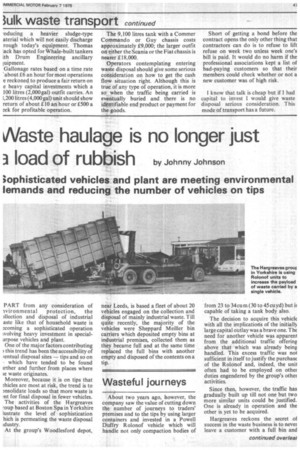
Page 50
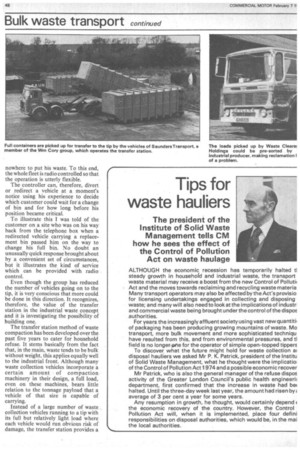
Page 51
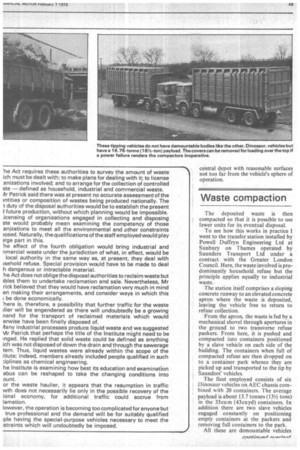
Page 52
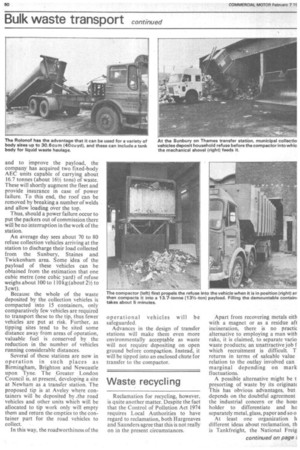
Page 55
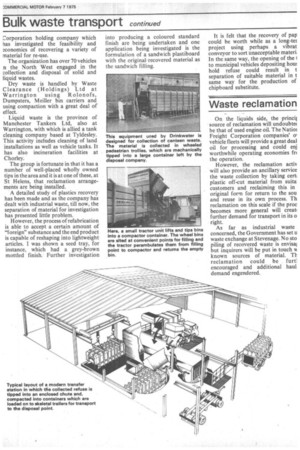
If you've noticed an error in this article please click here to report it so we can fix it.
3 load of rubbish by Johnny Johnson
;ophisticated vehicles and plant are meeting environmental !emends and reducing the number of vehicles on tips
PART from any consideration of ivironmental protection, the illection and disposal of industrial aste like that of household waste is ..coming a sophisticated operation ivolving heavy investment in specialurpose vehicles and plant.
One of the major factors contributing this trend has been the accessibility of ientual disposal sites — tips and so on which have tended to be found irther and further from places where le waste originates.
Moreover, because it is on tips that !.hicles are most at risk, the trend is to )nsolidate loads so that more waste is !nt for final disposal in fewer vehicles. The activities of the Hargreaves -oup based at Boston Spa in Yorkshire lustrate the level of sophistication hich is permeating the waste disposal idustry.
At the group's Woodlesford depot, near Leeds, is based a fleet of about 20 vehicles engaged on the collection and disposal of mainly industrial waste. Till quite recently, the majority of the vehicles were Sheppard Meiller bin carriers which deposited empty bins at industrial premises, collected them as they became full and at the same time replaced the full bins with another empty and disposed of the contents on a tip.
About two years ago, however, the company saw the value of cutting down the number of journeys to traders' premises and to the tips by using larger containers and invested in a Powell Duffry Rolonof vehicle which will handle not only compaction bodies of from 23 to 34 cum (30 to 45 cu yd) but if. capable of taking a tank body also.
The decision to acquire this vehicle with all the implications of the initial13, large capital outlay was a brave one. The need for another vehicle was apparent from the additional traffic offering above that which was already being handled. This excess traffic was not sufficient in itself to justify the purchase of the Rolcinof and, indeed, the unit often had to be employed on other duties engendered by the group's other activities.
Since then, however, the traffic has gradually built up till not one but two more similar units could be justified. One is already in operation and the other is yet to be acquired.
Hargreaves reckons the secret of success in the waste business is to never leave a customer with a full bin and nowhere to put his waste. To this end, the whole fleet is radio controlled so that the operation is utterly flexible.
The controller can, therefore, divert or redirect a vehicle at a moment's notice using his experience to decide which customer could wait for a change of bin and for how long before his position became critical.
To illustrate this I was told of the customer on a site who was on his way back from the telephone box when a redirected vehicle carrying a replacement bin passed him on the way to change his full bin. No doubt an unusually quick response brought about by a convenient set of circumstances, but it illustrates the kind of service which can be provided with radio control.
Even though the group has reduced the number of vehicles going on to the tip, it is very conscious that more could be done in this direction. It recognizes, therefore, the value of the transfer station in the industrial waste concept and it is investigating the possibility of building one.
The transfer station method of waste compaction has been developed over the past five years to cater for household refuse. It stems basically from the fact that, in the main, waste tends to be bulk without weight, this applies equally well to the industrial front. Although many waste collection vehicles incorporate a certain amount of compaction machinery in their design, a full load, even on these machines, bears little relation to the tonnage payload that a vehicle of that size is capable of carrying.
Instead of a large number of waste collection vehicles running to a tip with its full but relatively light load where each vehicle would run obvious risk of damage, the transfer station provides a central depot with reasonable surfaces not too far from the vehicle's sphere of operation.
The deposited waste is then compacted so that it is possible to use fewer units for its eventual disposal.
To see how this works in practice I went to the transfer station installed by Powell Duffryn Engineering Ltd at Sunbury on Thames operated by Saunders Transport Ltd under a contract with the Greater London Council. Here, the waste involved is predominantly household refuse but the principle applies equally to industrial waste.
The station itself comprises a sloping concrete runway to an elevated concrete apron where the waste is deposited, leaving the vehicle free to return to refuse collection.
From the apron, the waste is fed by a mechanical shovel through apertures in the ground to two transverse refuse packers. From here, it is pushed and compacted into containers positioned by a slave vehicle on each side of the building. The containers when full of compacted refuse are then dropped on to a container park whence they are picked up and transported to the tip by Saunders' vehicles.
The fleet employed consists of six Dinosaur vehicles on AEC chassis combined with 20 containers. The average payload is about 13.7 tonnes (131/2 tons) in the 33curn (43cu yd) containers. In addition there are two slave vehicles engaged constantly on positioning empty containers at the packers and removing full containers to the park.
All these are demountable vehicles
and to improve the payload, the company has acquired two fixed-body AEC units capable of carrying about 16.7 tonnes (about 161/2 tons) of waste. These will shortly augment the fleet and provide insurance in case of power failure. To this end, the roof can be removed by breaking a number of welds and allow loading over the top.
Thus, should a power failure occur to put the packers out of commission there will be no interruption in the work of the station.
An average day sees about 70 to 80 refuse collection vehicles arriving at the station to discharge their load collected from the Sunbury, Staines and Twickenham area. Some idea of the payload of these vehicles can be obtained from the estimation that one cubic metre (one cubic yard) of refuse weighs about 100 to 110 kg (about 2r/2 to 3 cwt).
Because the whole of the waste deposited by the collection vehicles is compacted into 15 containers, only comparatively few vehicles are required to transport these to the tip, thus fewer vehicles are put at risk. Further, as tipping sites tend to be sited some distance away from areas of operation, valuable fuel is conserved by the reduction in the number of vehicles running considerable distances.
Several of these stations are now in operation in such places as Birmingham, Brighton and Newcastle upon Tyne. The .Greater London Council is, at present, developing a site at Newham as a transfer station. The proposed tip is at Avelcy where containers will be deposited by the road vehicles and other units which will be allocated to tip work only will empty them and return the empties to the container part for the road vehicles to collect.
In this way, the roadworthiness of the operational vehicles will be safeguarded.
Advances in the design of transfer stations will make them even more environmentally acceptable as waste will not require depositing on open ground before compaction. Instead, it will be tipped into an enclosed chute for transfer to the compactor.
Reclamation for recycling, however, is quite another matter. Despite the fact that the Control of Pollution Act 1974 requires Local Authorities to have regard to reclamation, both Hargreaves and Saunders agree that this is not really on in the present circumstances. Apart from recovering metals eith with a magnet or as a residue aft incineration, there is no practic alternative to employing a man with rake, it is claimed, to separate vario waste products: an unattractive job f which recruitment is difficult. T returns in terms of saleable value relation to the outlay involved can marginal depending on mark fluctuations.
A possible alternative might be t presorting of waste by its originate This has obvious advantages, but depends on the doubtful agreement the industrial concern or the how_ holder to differentiate and ha separately metal, glass, paper and so o At least one organization h different ideas about reclamation, th is Tankfreight, the National Freig Corporation holding company which has investigated the feasibility and economics of recovering a variety of material for re-use.
The organization has over 70 vehicles n the North West engaged in the collection and disposal of solid and liquid wastes.
Dry waste is handled by Waste Clearance (Holdings) Ltd at Warrington using Rolonofs, Dumpsters, Meiller bin carriers and using compaction with a great deal of effect.
Liquid waste is the province of Manchester Tankers Ltd, also at Warrington, with which is allied a tank cleaning company based at Tyldesley. This activity includes cleaning of land installations as well as vehicle tanks. It has also incineration facilities at Chorley.
The group is fortunate in that it has a number of well-placed wholly owned tips in the area and it is at one of these, at St Helens, that reclamation arrangements are being installed.
A detailed study of plastics recovery has been made and as the company has dealt with industrial waste, till now, the separation of material for investigation has presented little problem.
However, the process of refabrication is able to accept a certain amount of "f ore ign" substance and the end product is capable of reshaping into lightweight articles. I was shown a seed tray, for instance, which had a grey-brown mottled finish. Further investigation into producing a coloured standard finish are being undertaken and one application being investigated is the formulation of a sandwich plastiboard with the original recovered material as the sandwich filling. It is felt that the recovery of pap could be worth while as a long-ter project using perhaps a vibrat conveyor to sort unacceptable materi. In the same way, the opening of the i to municipal vehicles depositing holm hold refuse could result in t separation of suitable material in t same way for the production of chipboard substitute.
On the liquids side, the princii source of reclamation will undoubtec be that of used engine oil. The Natio' Freight Corporation companies' o, vehicle fleets will provide a great deal oil for processing and could enj worthwhile operating economies ft.( the operation.
However, the reclamation activ will also provide an ancillary service the waste collection by taking cert; plastic off-cut material from suita customers and reclaiming this in original form for return to the sou and reuse in its own process. Th reclamation on this scale if the proc becomes more _general will creati further demand for transport in its o right.
As far as industrial waste concerned, the Government has set u waste exchange at Stevenage. No sto piling of recovered waste is envisai but inquirers will be put in touch known sources of material. Th reclamation could be furtl encouraged and additional haul demand engendered.












































































































































